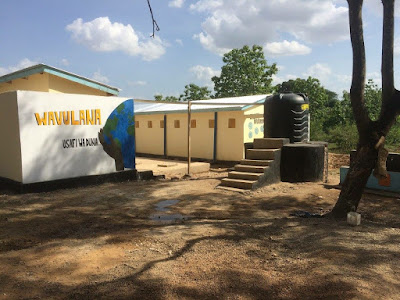Groundwater
Groundwater is the most abundant and readily available source of freshwater, and in fact accounts for
> 90% of accessible freshwater worldwide (Figure 1). The abundance of groundwater is largely influenced by climate variability and change through replenishment by recharge, and indirectly through groundwater use. These impacts can be modified by human activity such as land-use change
(Taylor, 2012).
Figure 1: Groundwater storage for Africa based on the effective porosity and saturated aquifer thickness
Potential for ground Water recharge
A shift towards few but heavier rainfall events is expected due to climate change in the East African region, this is expected to lead to more frequent and intense floods as well as variable and lower soil moisture.
Based on records from the Makuyapora Wellfield, Tanzania 1955- 2010,
Taylor (2013) finds that groundwater levels have been declining due to over abstraction. People have been removing water from the deep granite aquifer to provide water to the capital. Abstraction has increased from 0.1million
m3 to 0.9million
m3 per month in this time period, however supplies have not. This appears to be because episodic recharge events are sustaining intense abstraction.
Figure 2: Analysis of the relationship between groundwater recharge and rainfall
As shown in figure 2, for a large proportion of the record, there is no recharge. Recharge only occurs when there is highly intense seasonal rainfall. Recharge results disproportionately from > the 80th percentile. A non- linear relationship between rainfall and recharge is demonstrated, where intense seasonal rainfall associated with ENSO and the IOD contributes disproportionately to recharge.
Taylor (2013), shows that projected intensification of rainfall under climate change may favour recharge. Therefore, in a warmer world, where we see more intense rainfall events, groundwater may be a viable adaptation to support longer droughts and lower soil moisture. However, there are many problems that arise.
Problems
Uncertainties
Long- term monitoring data is generally lacking across the East African region, and in cases where data is available, there is more often than not, inconsistencies due to varying methodologies used. This can make comparisons and identifying trends challenging
(Comte, 2016). One key uncertainty is whether soil infiltration capacities will be able to transmit heavy rainfall, and therefore actually generate increases in groundwater recharge as the models show
(Taylor, 2013). There is also uncertainties of whether increased rates of potential evapotranspiration from warmer air temperatures will induce groundwater recharge
(Kingston, 2009). A very important uncertainty, lies in the assumption that all increasing intensive rainfalls will contribute equally to groundwater recharge.
Barriers to development
Socio- economic and political factors can cause groundwater development costs to be higher than they would otherwise. According to
Giordano (2006) the typical reasons for this include lack of local manufacturing capability, high duties on imported equipment, high energy costs, and poor supporting infrastructure such as road networks and electricians.
Furthermore, in some cases there has been national and donor policy that has undermined groundwater development. The push by donors and governments to invest in large scale irrigation schemes for example dams, may have drawn financial capital away from groundwater development. Furthermore the numerous large scale schemes that have failed in the past, may turn 'farmer sentiment away from irrigation expansion'
(Giordano, 2006).
Influences on supply
Changes in total volume in precipitation largely influences the supply of Groundwater.
The recharge of groundwater due to climate change can also be affected by other influences such as over abstraction and land- use change. Increasing demand due to population growth and economic development, can lead to an increase in the use of groundwater supplies. If demand outstrips supply, these resources will be depleted.
(Carter, 2009).
At the continent level East Africa has the second highest rate of population growth. In contrast to inland areas where abstraction is only limited by aquifer productivity and available recharge. Coastal aquifers are susceptible to seawater intrusion, if not managed carefully due to being low- lying and shallow water tables. Salt water intrusion is already a risk to groundwater supplies if over abstracted, however, it is higher in coastal regions.
The combination of increasing rainfall extremity, increase in sea level rise (cause saltwater intrusion), increased urbanisation (results in increased surface runoff from land clearance), and increased demand for water (increased abstraction), puts coastal regions of East Africa at risk. All these factors have already, but will have further negative implications on groundwater recharge. Although recharge is projected to increase with climate change, fresh groundwater availability will likely decrease in coastal areas if an effective management regime, involving communities is not introduced
(Comte, 2016).
Hydropolitical issues
There is an issue that aquifers may be transboundary, this creates hydropolitical issues
(Taylor, 2009). A transboundary aquifer is a body of groundwater which is intersected by two or more countries with the potential threat of dispute over shared groundwater resources.
Abiye (2010) examined the transboundary aquifers in 6 East African countries (Ethiopia, Eritrea, Sudan, Kenya, Somalia and Djibouti). Although these countries are yet to give major attention to the groundwater contained in these transboundary aquifers, the author stresses the need for a change. They state the future trend is steering towards increased exploitation of these reserves due to water shortages. Therefore, systematic development of these resources is needed to strengthen cooperation, and reduce the potential for conflict.
Concluding thoughts
Through increased recharge from more intense rainfall events, Groundwater can enhance the resilience of domestic, agricultural and industrial uses of freshwater in the face of increasing climate variability and change. There are many issues that arise especially from increased population growth and economic development, that puts groundwater resources at risk from over abstraction, salt water intrusion and pollution. There is also the potential for conflict over transboundary resources. Therefore, for groundwater to be sustainably seen as a solution, it needs to be integrated into national policy and requires development of adequate cross- sector dialogue within government, as well as enhancing communities in the management process.






















